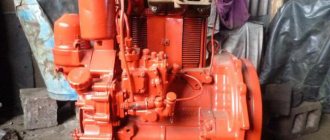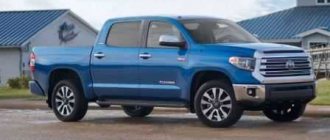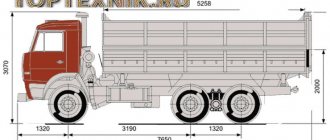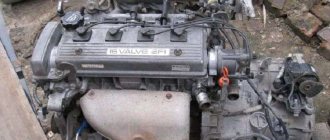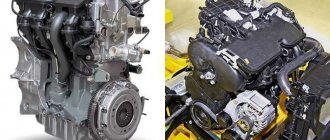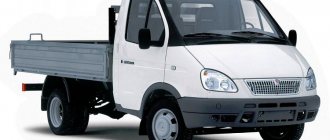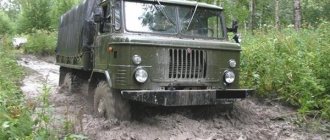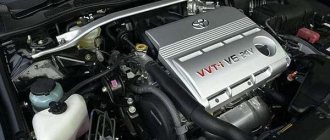Gas 66 is a well-known all-wheel drive truck with two axles and high payload capacity. Durability and incomparable cross-country ability distinguish this model from similar equipment. The Soviet Union created legendary cars that are still popular today. One of these unique vehicles is Gas 66. This equipment was created to overcome off-road conditions. Equipment with compact dimensions and a simple design is used to transport goods and people along impassable routes.
Purpose
When creating the model, the designers were guided by the desires of the military sphere. The vehicle was used in the army to transport airborne troops. There were also other areas of application:
- oil industry;
- gas industry;
- forestry;
- geology.
The equipment transported drilling tools, heavy equipment, and instruments. In modern conditions, the car is used for active recreation of tourists on the coast.
Gas 66
GAZ-66 Fuel consumption Dimensions Load capacity Weight Tank volume
The GAZ-66 all-wheel drive truck became a living legend even during the years of its mass production. More than half a century after its creation, this unique machine continues to be widely used both by organizers of hunting raids and resort rides, and by those who often have to deal “not with roads, but with directions.” Such a long service of the GAZ-66 was ensured by its excellent off-road characteristics, with a relatively compact size and simple design.
Specifications
When developing the car, the task was to produce a stable, powerful product. Auto Gas 66 has the following technical indicators:
- load capacity – 2 t;
- the largest mass of transported cargo is 5.9 tons;
- dimensions – 5.8x2.32x2.52 m;
- ground clearance - 315 mm;
- front wheel track - 18 cm;
- rear wheel track - 17.5 cm;
- the greatest depth of the ford to be overcome is 8 m;
- highest speed – 90 km/h;
- tire pressure – 0.5-3.0 kg/cm2.
The technical characteristics of the car are designed for driving on poor terrain.
Engine characteristics
When developing the model, it was decided to equip it with a motor from the Zavolzhsky Motor Plant. Military Gas 66 had a four-stroke engine with eight carburetor cylinders. Due to the V-shaped design, the unit was small in size.
Main characteristics:
- motor brand – ZMZ-66-06;
- engine type – petrol;
- volume – 4.254 l;
- power – 120 hp;
- cooling type – liquid;
- highest torque – 284.4 Nm;
- rotation speed – 2500 rpm;
- cylinder diameter – 9.2 cm;
- piston stroke – 8 cm;
- type of carburetor - K-126, K-135;
- material of manufacture – aluminum alloy;
- motor weight – 262 kg.
Be sure to read: Technical characteristics of GAZ-330232
For starting in the cold season, a pre-start heater PBZh-12 is provided. At the end of the 80s, the car was equipped with a ZMZ-513-10 engine with a power of 125 hp. Later, power units running on diesel fuel with a turbo system were developed. The modification with such an engine was listed as Gas 6641.
Cabin Gas 66
Cabin
The Gas 66 cabin has a super-engine arrangement. The structure is made of solid metal. The cabin is equipped with two seats for the driver and passenger. They are separated by a metal casing designed to cover the motor. At subzero temperatures, the casing served as an additional heat supply device due to the heated engine. For the comfort of long trips, a suspended sleeping place is installed, consisting of a hammock and hooks. There are ventilation holes and heaters. The front windows are equipped with wipers and washing mechanisms. The windshield is also ventilated. To get to the engine, the cab must be tilted forward. This is done easily thanks to the presence of hinges. Due to the non-removable motor casing, the gear selector is located away from the driver: on the lower right. The size of the Gas 66 cabin is 2.42x2.49x2.32 m, taking into account the height of the wheels.
Fuel consumption
The tank of the car is designed for 210 liters. At an average speed of 70 km/h, 20-25 liters are consumed per 100 kilometers.
Modifications of GAZ 66
Most modifications were developed for military transport tasks. For example:
- R-142 - command and staff vehicle for control and radio communications;
- MZ-66 - oil tanker;
- AS-66 - medical vehicle for evacuation and first aid;
- AP-2 - “mobile dressing room”, i.e. a mobile medical station;
- DDA-2 - disinfection unit, equipped with a shower;
- BM-21V - jet system.
At first, the vehicle was widely used for transporting guns and mortars (until their weight required a more heavy-duty tractor). It was in high demand in agriculture, construction, geodesy and geological exploration for transporting people and goods. In particular, a dump truck and a truck tractor were created on the basis of the “sixty-sixth”.
It is worth noting modern modifications of the car. Nowadays, the model continues to be fully operational, but some components are clearly outdated, so the owners are trying to replace them. For example, very popular solutions are replacing the engine with more powerful and economical diesel versions, as well as replacing the gearbox.
Car owners often strive to improve the comfort of the interior: they equip it with good heat and sound insulation, and install more comfortable seats. In addition, the car has become a convenient basis for creating a “mobile home”. Using a KUNG van, you can turn the body into a comfortable place where you can spend several days hunting or fishing. Elements of external tuning are also used: the “sixty-sixths” are equipped with additional lighting, arched tires that increase cross-country ability, a roof rack and roof racks. Original color schemes for car painting are also popular, and anti-corrosion treatment of the body is absolutely necessary in our climate.
Device
The car consists of a cabin and a body. The body part is covered with an awning. Inside there are benches with a reclining function. The body part is made of a solid metal platform. There are sides with bars on both sides. There is a folding side at the rear. The Gas 66 body dimensions correspond to 3.31 m in length and 2.05 m in width. The all-terrain capability of the vehicle is ensured by an all-wheel drive system, short overhangs and single-pitch tires. The rear axle is divided into components:
- crankcase;
- assembled gearbox;
- two axle shafts;
- pair of trunnions
The gearbox is provided with a certain thickening in the crankcase. The front axle contains:
- gearbox (as in the rear axle);
- constant velocity joints.
Be sure to read: Valve clearances D-245, engine adjustment
Periodic lubrication of the hinges extends the life of the axles. The car is braked by a hydraulic system with a vacuum booster. This mechanism prevents the motor from turning off when moving downhill. A hydraulic booster is also installed for the steering mechanism. In 1968, Gas 66 was equipped with a centralized system for regulating air in tires. The air pressure is changed from the driver's seat. You can do this while driving and while parked. This system assumes that movement can be maintained in the event of minor tire damage.
gearbox has 4 stages with synchronization in 3rd and 4th gears. Single-disc clutch with hydraulic drive. The transmission is also formed by a transfer case with 2 stages. This box amplifies torque and is responsible for distributing it across the axles. The suspension is formed by semi-elliptical longitudinal springs. Telescopic spring shock absorbers with simplex pitch and hydraulics. It is impossible to load the car beyond the norm due to the presence of single springs on the rear axle. Overload is also prevented by self-locking differentials in the main gears. Everything about Gas 66 can be found on the global network.
Gas 66 engine oil what is the viscosity. Refill containers and standards
GAZ 66 is a military vehicle. For a long time, the power unit of the 66 was in operation and was in faithful service of the armed forces. The motor is quite powerful, despite the design flaws.
Specifications
The Gorky Automobile Plant did not produce its own engines and ordered motor production from the Zavolzhsky Motor Plant. The 66s were equipped with power units that were marked ZMZ 513.
Many people mistakenly believe that the GAZ 66 and ZMZ 513 engines are different engines, but this is not so. According to official information from the car manufacturer, the vehicles were equipped with 513 Zavolzhsky power units.
Let's consider the main technical characteristics that the GAZ 66 (ZMZ 513) engine has:
Based on the 513, the D-245 diesel unit was developed, which was also installed on the 66th Lawn, but in significantly smaller quantities than its gasoline counterparts. Let's consider its main technical characteristics:
The applicability of the engine was not limited to the 66th, but these power units were also installed on the GAZ 3307, as well as the ZIL 130. This is a V-shaped power unit, which has some characteristic differences - a specific pan, a large air and oil filter. The 513 features an increased weight of 275 kg.
Service
Since the design of the ZMZ 513 engine is similar to the 511, it is serviced identically. Scheduled maintenance is carried out every 15,000 km.
So, in order to increase the resource of the power unit, it is necessary to carry out scheduled maintenance correctly and most importantly on time. Many motorists do not understand what should be included in this process. So, let’s look at what operations are included in scheduled maintenance:
- Replacing engine lubricant.
- Replacing the oil filter element.
- Adjustment of the valve mechanism (every 30,000 km).
- Replacing the air filter (after 25,000 km).
- Diagnostics of spark plugs (every 20,000 km).
- Checking the condition of the gas distribution mechanism (every 30,000 km).
If you look at it, often motorists only change the oil and filter. Valve adjustment is carried out only if a characteristic metallic ringing is already heard.
Repair
Since the motor was developed on the basis of the 511, the problems are the same as those of its older brother. The main problem can be considered the cooling system. By and large, the owners of the power unit are to blame themselves, since they operate the engine on water, which leads to corrosion of the main structural elements. Also, it is worth noting that the weak link of the unit can be called the thermostat and the water pump, which quite often fail.
The disadvantage of the engine is increased fuel consumption. Many motorists have experimented with reducing fuel consumption. The most effective option remains replacing the carburetor.
Engine owners prefer to repair the GAZ 66 engine themselves, but when it comes to major repairs, they cannot do without special equipment. In this case, the power unit is sent to a specialized car service.
Change of oil
Replacing the lubricant in the engine is quite simple. We wait until the engine cools down. We find the drain hole and place a container under it in the size of 10 liters. Typically, the ZMZ 513 engine fits 9.6 - 9.8 liters. Now that everything is ready, you can proceed directly to the work of changing the oil:
- Unscrew the drain plug.
- We wait until the oil drains.
- We tighten the drain plug, replacing the o-ring.
- Pour oil through the filler neck.
As practice shows, a large number of owners of the ZMZ 513 engine use motor oil marked M-10 or M-10G.
It is perfect for this power unit and has all the necessary technical and physical properties to ensure normal operation and protection of engine parts.
Conclusion
The GAZ 66 engine received a fairly wide
nashipoezda.ru
Advantages and disadvantages
The main advantages of the Gas 66 technology include:
- overcoming rough terrain and shallow rivers;
- four-wheel drive;
- high ability to perform various maneuvers despite the large load capacity;
- excellent balancing favors load distribution on both axles;
- unpretentiousness in maintenance;
- centralized tire balancing;
- long service life.
The disadvantages of the technology include the location of the cabin above the wheels. This arrangement reduces driver protection. This cabin design reduces the dimensions of the Gas 66.
Controllability
Increased cross-country ability of the vehicle is made possible thanks to the drive on both axles and the use of self-locking differentials on both axles. Owners speak highly of the fairly high ground clearance of 315 mm, which allows them to overcome obstacles even in the form of small bodies of water, the depth of which, by the way, can far exceed the ground clearance itself. The tire pressure regulation system is very helpful for motorists: the truck is equipped with an engine-driven compressor to inflate the tires. Equipping the engine with a pre-heater also has a positive effect.
Since the car is equipped with a hydraulic separate brake system with a vacuum booster, it will not be possible to coast with the engine turned off, unfortunately for many drivers. But the presence of hydraulic power steering makes it easier for users to handle turns on difficult roads.
Gas 66 with a winch
An important positive aspect of this car : the center of gravity is balanced and the loads on the front and rear axles are almost equal. As a result, the vehicle is able to land on all four wheels at once without blocking the cabin when jumping from small obstacles such as springboards, which makes the GAZ 66 military especially popular when used in airborne troops.
What can be included with
Various modifications require installation of additional equipment. Modifications 02,05,12,15,52 are equipped with a mechanical winch. The winch moves due to the power take-off through 2 cardans and a connecting support located in the gap. Gas 66 05 had a winch 50 m long and 1.6 cm thick. Thanks to the presence of this device, the traction load increases to 3.5 tons. Modifications E,04,05,14,15 were equipped with shielded equipment. The manufacturer also developed special modifications for the northern and southern territories. Gas 66 92 was produced in 1987-1995 and was popular in the northern regions. Variety 91 was produced for hot latitudes and was exported. Technical characteristics of Gas 66 15 made it possible to connect the winch and noise-proof electrical equipment. This variety has been produced since 1985.
Military Gas 66
______________________________________________________________________________
All-wheel drive car GAZ-66
The GAZ-66 cross-country vehicle with a load capacity of 2 tons is designed for transporting goods and people in various road conditions and off-road. The car is manufactured in different versions and is designed for operation at ambient temperatures from plus 50 to minus 45 ° C. The GAZ-66 car can tow a trailer that has a coupling device, electrical outlets, and a two-wire pneumatic brake system drive. The car is equipped with an eight-cylinder GAZ-53 liquid-cooled carburetor engine. All wheels of the GAZ-66 car are single-wheel drive. Tire size 12.00-18. The transmission is eight-speed without a center differential. The transmission gear ratio range is 14.7. The main gear is hypoid. Self-locking cam cross-axle differentials are installed. The equipment of the car also included power steering, a hydraulic vacuum booster in the brake drive, and a windshield washer. Main modifications of the GAZ-66 car GAZ-66-11 - the main modification; GAZ-66-12 - with a winch; GAZ-66-14 - with shielded electrical equipment; GAZ-66-15 - with a winch and shielded electrical equipment. General data and parameters of GAZ-66 Type - Two-axle truck with drive on both axles Weight of transported cargo, kg - 2000 Maximum gross weight of the trailer, kg - 2000 Gross vehicle weight no more than, kg: - without winch - 5770 - with winch - 5940 Weight of the vehicle in running order (without additional equipment), kg: - without winch - 3440 - with winch - 3610 Overall dimensions of the GAZ-66 vehicle (mm) length - 5805 width - 2525 height (in the cabin, without load) - 2490 Base - 3300 Front wheel track - 1800 Rear wheel track - 1750 Vehicle ground clearance with full load (under the front and rear axle housings) - 315 Turning radius along the outer front wheel track, m - 9.5 Highest speed with full load, without a trailer, on horizontal sections of a flat highway, km/h, not less than 90
Control fuel consumption when measured in the summer for a run-in car moving with a full load in fourth gear at a constant speed of 60 km/h on a dry, flat road with an improved surface and short inclines not exceeding 0.5°, l/100 km - 20
Braking distance of a car with a full load without a trailer moving at a speed of 50 km/h, m - 25 Depth of fording on a hard bottom, no more than, m - 1 Overhang angles (with a full load), degrees: - front - 35 - rear - 32 The greatest angle of incline a vehicle can overcome with full load, degrees. — 31 Loading height, mm — 1110 Vehicle engine GAZ-66 Type — 4-stroke, carburetor, gasoline Number of cylinders and their arrangement — 8, V-shaped Cylinder diameter, mm — 92 Piston stroke, mm — 80 Cylinder displacement, l — 4.25 Compression ratio — 7.6 Rated gross power (with limiter) at 3200 rpm, kW (hp) — 88.5 (120) Maximum torque at 2000–2500 rpm, Nm ( kg/cm) — 29 (29) Cylinder operating order 1 —5—4—2—6—3—7—8 Direction of crankshaft rotation — right Lubrication system — Combined: under pressure and splash, with full-flow filtration. Engine cooling - Liquid, forced, with a centrifugal pump and expansion tank. The cooling system has a thermostat installed in the exhaust pipe. Carburetor - K-135, two-chamber, balanced with falling flow Speed limiter - Pneumatic centrifugal type Starting heater - PZhB-12 Transmission GAZ-66 Clutch GAZ-66 - Single-disc, dry Gearbox GAZ-66 - Three-way. 4-speed Gearbox ratios - 1st gear - 6.55; 2nd gear—3.09; 3rd gear—1.71; 4th gear—1.0; reverse gear—7.77 Transfer case—Has two gears: direct and reduction with a gear ratio of 1.982 Cardan transmission—Open. Has three shafts. The main gear of the drive axles is conical, hypoid type. Differential - Cam type. Steering knuckles GAZ-66 - There are constant velocity joints (CV joints). Axle shafts - Fully unloaded. Chassis GAZ-66 Frame - Stamped, riveted. Wheels - Disc with rim 228G-457, with bead and split locking rings. Tires - Pneumatic, sizes 320-457 (12.00-18) Installation of front wheels - Wheel camber angle 0°45′. The angle of lateral inclination of the king pin is 9°. The angle of inclination of the lower end of the kingpin forward is 3°30′. Wheel alignment is 2-5 mm. Springs - Four, longitudinal, semi-elliptical Shock absorbers - Hydraulic, telescopic, double-acting. Installed on both axles of the vehicle. Steering of the GAZ-66 car Type of the steering mechanism of the GAZ-66 - Globoid worm with a three-ridge roller 21.3 (average). Power steering - Hydraulic Longitudinal steering rod - Tubular. The connections of the rod with the bipod and the steering knuckle lever have ball pins and springs, the tightening of which is adjustable. The transverse steering rod is a rod, connected to the steering knuckles by means of ball pins. Brakes GAZ-66 Working brake system GAZ-66 - Double-circuit with hydraulic drive and hydraulic vacuum booster in each circuit; has a two-line pneumatic outlet for controlling the trailer brakes. Brake mechanisms are shoe, drum type. Spare brake system - Each circuit of the service brake system. Parking Brake System - Mechanically driven to the brake mechanism located on the transmission. Cabin and platform of the GAZ-66 vehicle Cabin - Double, metal, tilting forward. The cabin is equipped with a heater, a windshield wiper, an electric windshield washer, two sun visors, two rear-view mirrors, a driver's berth, brackets for fastening seat belts, two floor mats, and a road train sign. Platform - Metal. Rear tailgate (wood-metal). Special equipment of the GAZ-66 car Power take-off box KOM - Has two gears: for winding and unwinding the winch cable. Winch - The maximum traction force on the cable is 3000 N (3000 kgf) when the drum is fully wound (upper row of winding) and 4000-4500 N (4000-4500 kgf) when the drum is completely unwound (lower row of winding). Cable length 50 m. The winch is driven by cardan shafts from the power take-off.
______________________________________________________________________________
______________________________________________________________________________
- Clutch GAZ-3308, 3309
- Dismantling the GAZ-3308, 3309 gearbox
- Drive axles GAZ-3308
- Transfer case and cardans GAZ-3308
- Cardans GAZ-3307, 3309
- Rear axle GAZ-3309, 3307
- Suspension GAZ-3309
- Steering GAZ-3309
______________________________________________________________________________
______________________________________________________________________________
- Clutch GAZ-53, 3307
- Gearbox GAZ-53, 66
- Rear axle GAZ-53
- Steering GAZ-53, 66
- Ignition installation GAZ-53
- Clutch GAZ-66
- Drive axles GAZ-66
- Brake system GAZ-66
- Winch and power take-off GAZ-66
- Operating systems of the GAZ-66, GAZ-3307 engine
- Engine ZMZ-402 Gazelle GAZ-2705
- Clutch Gazelle GAZ-2705
- Gazelle GAZ-2705 gearbox
- Front axle Gazelle GAZ-2705
- Cylinder head and camshaft Cummins ISF 2.8
- Fuel system of the Gazelle Cummins ISF 2.8 engine
- Cylinder block and piston group of the Cummins ISF 2.8 engine
- Crankshaft engine Cummins ISF 2.8 Gazelle
- Engine Cummins Valdai GAZ-33106
- Clutch and gearbox Valdai
- Bridges Valdai
- Steering Valdai
Catalogs of spare parts and assembly parts
Vehicle application
From the moment it left the production line, the GAZ-66 found many fans among workers and military people. The Airborne Forces received an excellent cross-country vehicle. Thanks to its balance, it did not fall over after landing during the airdrop. The command and staff vehicle (CSV), necessary for large-scale landing operations, was received.
True, the further military fate of the “sixty-sixth” did not work out. In a combat situation, it quickly became clear that hitting a mine meant the loss of the driver.
It is for this reason that the GAZ-66 was not popular in OKSVA; in conditions of a mine war on the roads, the car showed complete failure.
The “shishiga” is gradually being abandoned, but for the military it remains a legend.
The maneuverability impressed not only the Americans, but even our seasoned soldiers and officers. Particularly appreciated was the tire pressure regulation system, so necessary in the military environment.
The “sixty-sixth” was of great importance for the national economy. In whatever difficult situation the work was carried out, this particular machine could get there. The installed winch made the vehicle's maneuverability even higher.
The main disadvantage was the gasoline engine, which consumed 24 liters per 100 kilometers. Drivers will understand that these are approximate numbers and are prone to increase.
